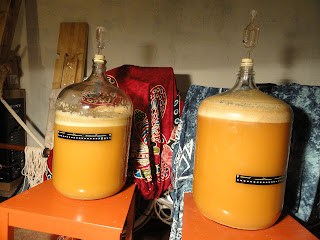The most prominent benefit of using secondary fermentation is that your beer will have a much purer taste. Your beer will also have a much clearer look to it if you use this process. Amber will have a beautiful red clarity, showing off the fine colors roasted into the grains, while a pale ale will shine glowingly in the evening sun. With secondary fermentation, the natural clarity of your beer will really come out. Even for the dark beers this is important, because the cloudiness that can ensue from sediment mixing will actually make the beer look less dark.
To help us understand why brewers use secondary fermentors lets look into the different phases of fermentation. When your beer first begins to ferment, it will go through a few phases very quickly. The first phase is an aerobic phase where the yeast cells adapt to their environment and multiply very quickly but do not produce much alcohol. It is during this phase that the yeast actually need oxygen in the beer in order to do their work. This phase only lasts for a few hours in most cases, and you cannot see anything happening with the naked eye.
The yeast then begin to metabolize the sugars into CO2 and Ethanol during their anaerobic phase. This is the part you can see as a foamy head or “Krausen” on the top of the fermenting beer. The CO2 is evident in the airlock as the bubbles begin to pop faster and faster(see video). This phase of fermentation is very active and usually lasts a couple days to a week.
 The following chart shows the cycles of the yeast as it ferments your beer:
The following chart shows the cycles of the yeast as it ferments your beer: Most Ales will spend the majority of their "conditioning" phase in bottles; getting themselves nice and carbonated.
Most homebrewers use Carboys to transfer the beer once the active yeast cycle is over.
 When using a glass Carboy, make sure it is in a dark place where light can’t get to it, or else wrap it in a blanket or towel to keep sunlight off. Sunlight will cause the beer to get “skunky“. Although the term is frequently used to describe beer that’s gone bad for any variety of reasons, to be precise “skunked beer” refers to beer that’s been over-exposed to sunlight, or “light-struck.” Regardless of what your favorite type of beer is, there are plenty of ways to ruin it, overexposure to light is the only way to skunk it.
When using a glass Carboy, make sure it is in a dark place where light can’t get to it, or else wrap it in a blanket or towel to keep sunlight off. Sunlight will cause the beer to get “skunky“. Although the term is frequently used to describe beer that’s gone bad for any variety of reasons, to be precise “skunked beer” refers to beer that’s been over-exposed to sunlight, or “light-struck.” Regardless of what your favorite type of beer is, there are plenty of ways to ruin it, overexposure to light is the only way to skunk it. It helps that when you place your carboy(s) for the initial fermentation, they are somewhere up high, where you can later siphon them using gravity. If you move your carboy just before siphoning it into the secondary fermentation vessel, you will severely sabotage your efforts to leave behind the sediment. The jarring and sloshing will mix some of the sediment back into your brew, thereby negating the full effectiveness of the process of secondary fermentation!
All in all, secondary fermentation is a very important step towards refining your home brew.




WOW well said Queen B well said indeed!
ReplyDeleteMega props, Kelli, on this awesome post! I'm not even gonna try to one up this.
ReplyDelete